Harris C.M., Piersol A.G. Harris Shock and vibration handbook
Подождите немного. Документ загружается.

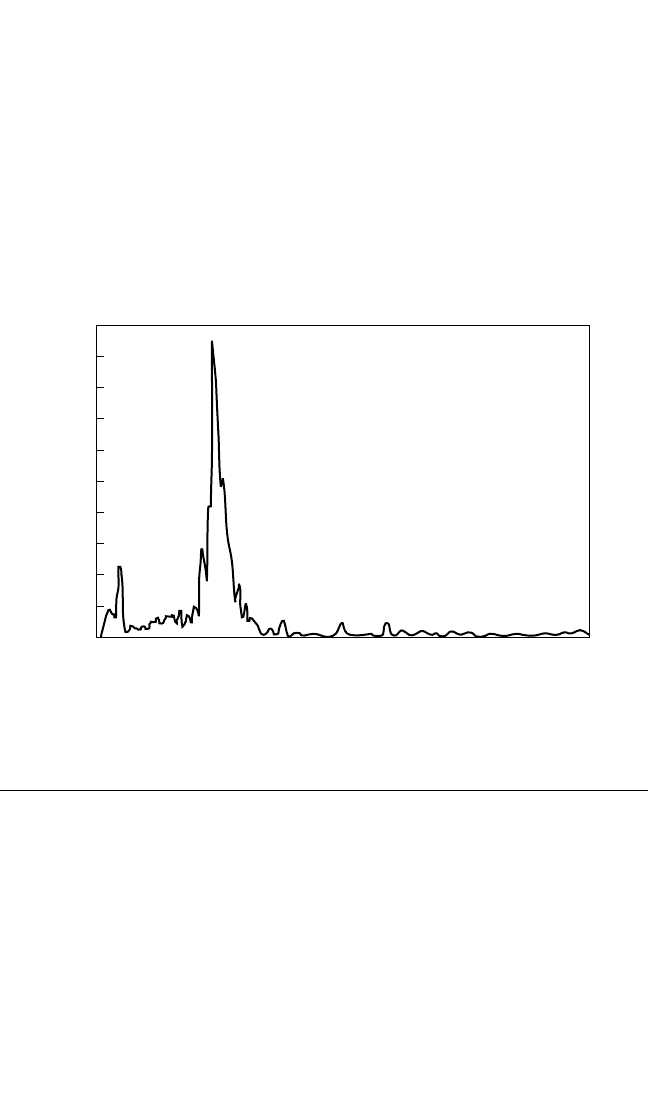
dependent and the gap between the magnetic pickup and the toothed wheel is less
than 0.025 in. the proximity probe is preferred—especially in synchronous motor
startups.
TORSIONAL ANALYSIS
A torsional signal must be analyzed for frequency components using a spectrum
analyzer, described in Chap. 14. Figure 38.16 shows a torsional response spectrum
for a variable-frequency motor-driven pump. The pump ran at 408 rpm. The tor-
sional vibration response excited by the variable frequency motor is 0.23° at a fre-
quency of 38 Hz.
TORSIONAL VIBRATION IN RECIPROCATING AND ROTATING MACHINES 38.25
250
0
0
TORSIONAL RESPONSE, DEGREES/1000
FREQUENCY, Hz
f = 6.8 Hz
A = .054 deg.
f = 38 Hz
A = 0.23 deg.
DEG. START:
100
FIGURE 38.16 Torsional response of a variable-frequency motor-driven pump at
408 rpm. There are significant peaks at 6.8 and 38.0 Hz.
MEASURES OF CONTROL
The various methods which are available for avoiding a critical speed or reducing
the amplitude of vibration at the critical speed may be classified as:
1. Shifting the values of critical speeds by changes in mass and elasticity
2. Vector cancellation methods
3. Change in mass distribution to utilize the inherent damping in the system
4. Addition of dampers of various types
SHIFTING OF CRITICAL SPEEDS
If the stiffness of all the shafting to a system is increased in the ratio a, then all the
frequencies will increase in the ratio a, provided that there is no corresponding
8434_Harris_38_b.qxd 09/20/2001 12:26 PM Page 38.25

increase in the inertia. It is rarely possible to increase the crankshaft diameters on
modern engines; in order to reduce bearing pressures, bearing diameters usually are
made as large as practical. If bearing diameters are increased, the increase in the crit-
ical speed will be much smaller than indicated by the a ratio because a considerable
increase in the inertia will accompany the increase in diameter. Changes in the stiff-
ness of a system made near a nodal point will have maximum effect. Changes in iner-
tia near a loop will have maximum effect, while those near a node will have little
effect.
By the use of elastic couplings it may be possible to place certain critical speeds
below the operating speed where they are passed through only in starting and stop-
ping; this leaves a clear range above the critical speed. This procedure must be used
with caution because some critical speeds, for example the fourth order in an eight-
cylinder, four-cycle engine, are so violent that it may be dangerous to pass through
them. If the acceleration through the critical speed is sufficiently high, some reduc-
tion in amplitude may be attained, but with a practical rate the reduction may not be
large. The rate of deceleration when stopping is equally important. In some cases
mechanical clutches disconnect the driven machinery from the engine until the
engine has attained a speed above dangerous critical speeds. Elastic couplings may
take many forms including helical springs arranged tangentially, flat leaf springs
arranged longitudinally or radially, various arrangements using rubber, or small-
diameter shaft sections of high tensile steel.
1
VECTOR CANCELLATION METHODS
Choice of Crank Arrangement and Firing Order. The amplitude at certain
minor critical speeds sometimes can be reduced by a suitable choice of crank
arrangement and firing order (i.e., firing sequence).These fix the value of the vector
sum Σβ in Eq (38.25), M
m
= M
e
Σβ. But considerations of balance, bearing pres-
sures, and internal bending moments restrict this freedom of choice. Also, an
arrangement which decreases the amplitude at one order of critical speed invariably
increases the amplitude at others. In four-cycle engines with an even number of
cylinders, the amplitude at the half-order critical speeds is fixed by the firing order
because this determines the Σβ value.Tables 38.5 and 38.6 list the torsional-vibration
characteristics for the crank arrangements and firing orders, for eight-cylinder two-
and four-cycle engines having the most desirable properties.
The values of Σβ are calculated by assuming β=1 for the cylinder most remote
from the flywheel, assuming β=1/n for the cylinder adjacent to the flywheel (where
n is the number of cylinders), and assuming a linear variation of β there between. In
any actual installation Σβ must be calculated by taking β from the relative modal
curve; however, if the Σβ as determined above is small, it also will be small for the
actual β distribution. These arrangements assume equal crank angles and firing
intervals. The reverse arrangements (mirror images) have the same properties.
V-Type Engines. In V-type engines, it may be possible to choose an angle of the V
which will cancel certain criticals. Letting φ be the V angle between cylinder banks,
and q the order number of the critical, the general formula is
qφ=180°, 540°, 1080°, etc. (38.26)
For example, in an eight-cylinder engine the eighth order is canceled at angles of
22
1
⁄
2
°,67
1
⁄
2
°, 112
1
⁄
2
°, etc.
38.26 CHAPTER THIRTY-EIGHT
8434_Harris_38_b.qxd 09/20/2001 12:26 PM Page 38.26
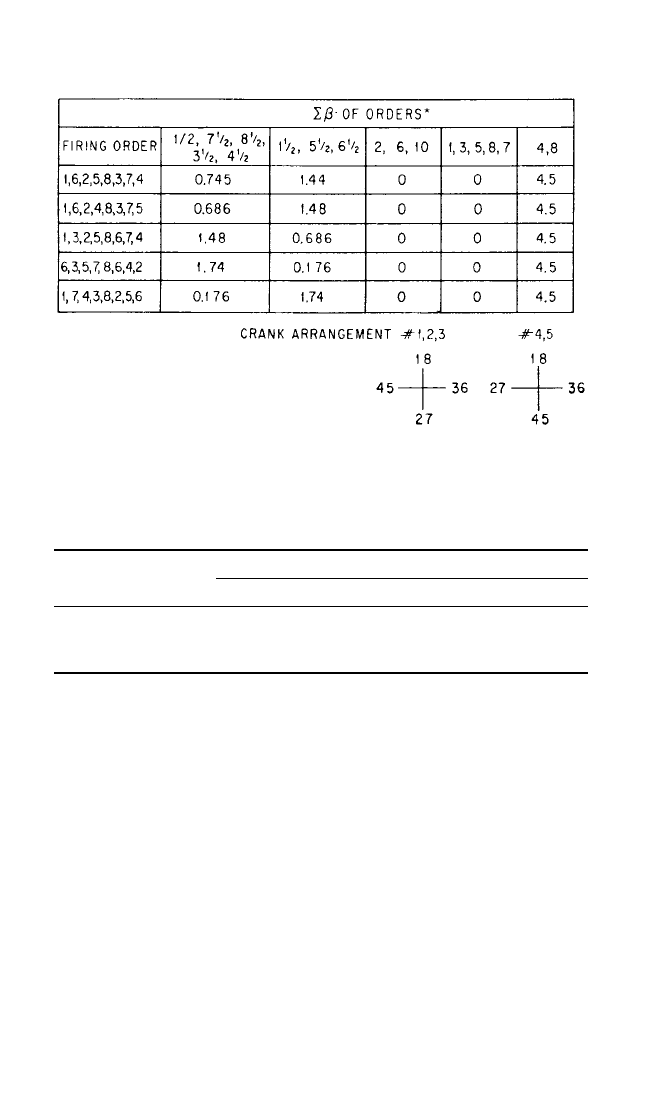
In four-cycle engines, φ is to be taken as the actual bank angle if the second-bank
cylinders fire directly after the first and as 360°+φif the second-bank cylinders omit
a revolution before firing. In the latter case the cancellation formula is
(φ+360°)q = n × 180° (38.27)
where n = 1, 3, 5, etc. For example, to cancel a 4.5-order critical the bank angle should
be
φ= =40° for direct firing
or
φ= −360°=80° for the 360° delay
Cancellation by Shift of the Node. If an engine can be arranged with approxi-
mately equal flywheel (or other rotors) at each end so that the node of a particular
11 × 180°
4.5
180°
4.5
TORSIONAL VIBRATION IN RECIPROCATING AND ROTATING MACHINES 38.27
TABLE 38.5 Torsional-Vibration Characteristics for Eight-Cylinder, Four-
Cycle Engine Having 90° Crank Spacing
TABLE 38.6 Torsional-Vibration Characteristics for Eight-Cylinder,Two-
Cycle Engine Having 45° Crank Spacing
Σβ of orders
Firing order 1, 7, 9 2, 6, 10 3, 5, 11 4, 12 8, 16
1, 8, 2, 6, 4, 5, 3, 7 0.056 0 0.79 2.0 4.5
1, 7, 4, 3, 8, 2, 5, 6 0.175 0 1.61 0 4.5
1, 6, 5, 2, 7, 4, 3, 8 0.112 0 1.58 0.5 4.5
* Values of 0 in the ∑β column indicate small but not necessarily 0 values for actual β
distribution.
8434_Harris_38_b.qxd 09/20/2001 12:26 PM Page 38.27
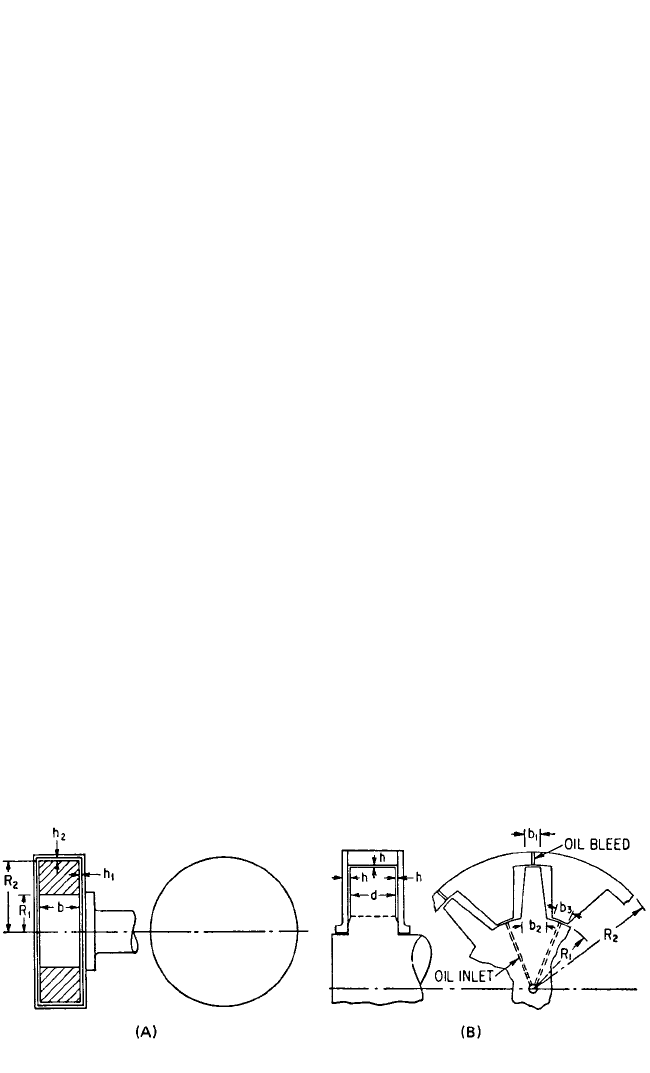
mode is at the center of the engine, Σβ will cancel for the major orders of that mode.
This procedure must be used with caution because the double flywheel arrangement
may reduce the natural frequency in such a manner that low-order minor criticals of
large amplitudes take the place of the canceled major criticals.
Reduction by Use of Propeller Damping in Marine Installations. From Eq.
(38.21) it is evident that the torque amplitude in the shaft can be reduced below any
desired level by making the flywheel moment of inertia I
1
of sufficient magnitude.
The ratio of the propeller amplitude to the engine amplitude increases as the fly-
wheel becomes larger; thus the effectiveness of the propeller as a damper is
increased.
DAMPERS
Many arrangements of dampers can be employed (see Chap. 6). In each type there
is a loose flywheel or inertia member which is coupled to the shaft by:
1. Coulomb friction (Lanchester damper)
2. Viscous fluid friction
3. Coulomb or viscous friction plus springs
4. Centrifugal force, equivalent to a spring having a constant proportional to the
square of the speed (pendulum damper) (see Chap. 6)
Each of these types acts by generating torques in opposition to the exciting torques.
The Lanchester damper illustrated in Fig. 6.35 has been entirely superseded by
designs in which fluid friction is utilized. In the Houdaille damper, Fig. 38.17, a fly-
wheel is mounted in an oiltight case with small clearances; the case is filled with sili-
cone fluid. The damping constant is
c = 2πµ
+
in.-lb-sec (38.28)
where µ is the viscosity of the fluid and r
1
, r
2
, b, h
1
, and h
2
are dimensions indicated in
Fig. 38.17.
r
2
4
− r
1
4
h
1
1
2
r
2
3
b
h
2
38.28 CHAPTER THIRTY-EIGHT
FIGURE 38.17 Schematic diagram of dampers. (A) Houdaille type. (B) Paddle type.
8434_Harris_38_b.qxd 09/20/2001 12:26 PM Page 38.28
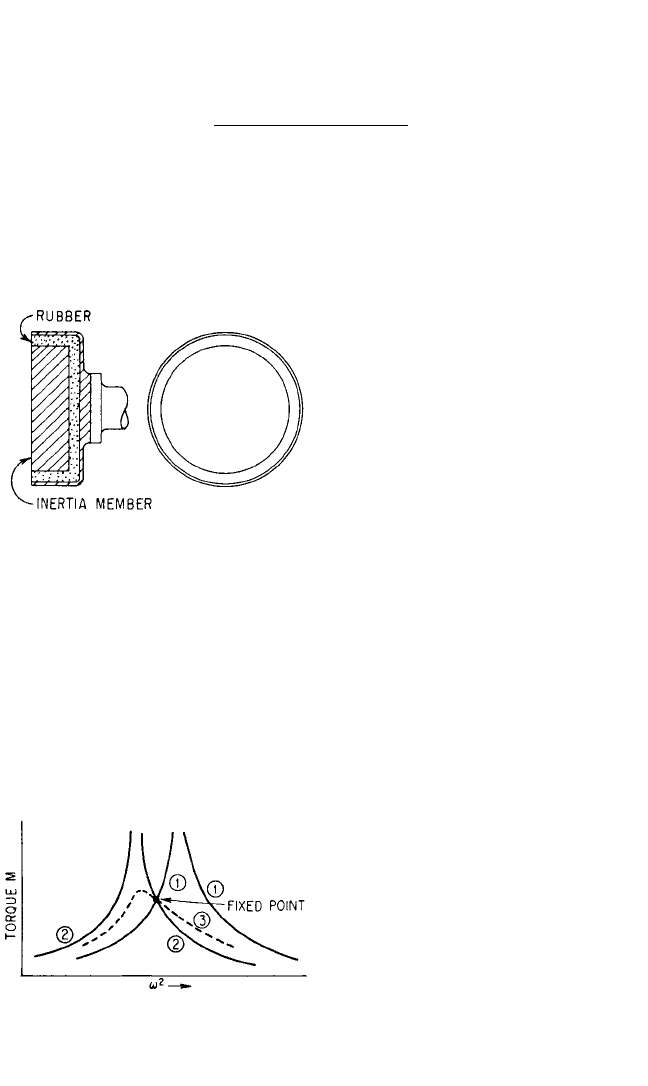
The paddle-type damper illustrated in Fig. 38.17 utilizes the engine lubricating oil
supplied through the crankshaft. It has the damping constant
c =
3µd
2
(r
2
2
− r
1
2
)
2
n
h
3
++
in.-lb-sec (38.29)
where n is the number of paddles, µ is the viscosity of the fluid, and b
1
, b
2
, r
1
, r
2
, and
d are dimensions indicated in Fig. 38.17. Other types of dampers are described in
Ref. 2.
The effectiveness of these dampers
may be increased somewhat by connect-
ing the flywheel to the engine by a
spring of proper stiffness, in addition to
the fluid friction. In one form, Fig. 38.18,
the connection is by rubber bonded
between the flywheel and the shaft
member. The rubber acts both as the
spring and by hysteresis as the energy
absorbing member. See Chaps. 32 and
34 for discussions of damping in rubber.
Dampers without and with springs are
defined here as untuned and tuned vis-
cous dampers, respectively.
In many cases the mode of vibration
to be damped is essentially internal to
the engine. Then the damper is located
at the end of the engine remote from the
flywheel. If the mode to be damped is essentially one between driven masses, other
locations may be desirable or necessary.
Design of the Untuned Viscous Damper, Exact Procedure. The first step in
the design procedure is to make a tentative assumption of the polar moment of iner-
tia of the floating inertia member. If the damper is attached to the forward end of the
crankshaft with the primary purpose of damping vibration in the engine, the size
should be from 5 to 25 per cent, depending on the severity of the critical to be
damped, of the total inertia in the
engine part of the system, excluding the
flywheel.
Usually it is advantageous to mini-
mize the torque in a particular shaft sec-
tion. This may be done as follows: For a
series of frequencies plot the resonance
curve of this torque, first without the
floating damper mass and then with the
damper mass locked to the damper hub.
Plot the curves with all ordinates posi-
tive. The nature of such a plot is shown
in Fig. 38.19. The point of intersection is
called the fixed point. The plot is shown
as if there were only one resonant fre-
4(r
2
− r
1
)
b
1
+ b
2
d
b
3
d
b
1
TORSIONAL VIBRATION IN RECIPROCATING AND ROTATING MACHINES 38.29
FIGURE 38.18 Schematic diagram of bonded
rubber damper.
FIGURE 38.19 Resonance curves for various
conditions of auxiliary mass dampers: (1)
damper free, c = 0; (2) damper locked, c =∞; (3)
auxiliary mass coupled to shaft by damping.
8434_Harris_38_b.qxd 09/20/2001 12:26 PM Page 38.29

quency. Usually only one is of interest, and the curves are plotted in its vicinity. If the
plot were extended, there would be a series of fixed points.
If a damping constant is assigned to the damper and the new resonance curve
plotted, it will be similar to curve 3 in Fig. 38.19 and will pass through the fixed point.
If there is no other damping in the system except that in the damper, all of the reso-
nance curves will pass through the fixed points, independent of the value assigned to
the damping constant.
13
Therefore, the amplitude at the fixed point is the lowest that
can be obtained for the assumed damper size. If this amplitude is too large, it will be
necessary to increase the damper size; if the amplitude is unnecessarily small, the
damper size can be decreased.When a satisfactory size of damper has been selected,
it is necessary to find the damping constant which will put the resonance curve
through the fixed point with a zero slope. Assume a value of ω
2
slightly lower than
its value at the fixed point, and compute the amplitude at that value of ω
2
with the
damping constant c entered as an algebraic unknown. Equating this amplitude to
that at the fixed point, the unknown damping constant c can be calculated. Repeat
the calculation with a value of ω
2
higher than the fixed point value by the same incre-
ment. The mean of the two values of c thus obtained will be as close to the optimum
value as construction of the damper will permit. In constructing these resonance
curves, it is not necessary to construct complete curves over a wide range of fre-
quencies but only over a short interval in the vicinity of the fixed point.
Two-Mass Approximation. If the system is replaced by a two-mass system in the
manner utilized to make a first estimate (see the section Natural Frequency Calcula-
tions) of the one-noded mode, the results are further approximated by the following
formulas:
For such a two-mass plus damper system the amplitude at the fixed point is given
by
13
M
12
= M
e
Σβ
(38.30)
where M
e
= Srh is the exciting torque per cylinder. The optimum damping is
c =
1/2
in.-lb/rad/sec (38.31)
where I
1
= polar moment of inertia for flywheel or generator
I
2
= 40 percent of engine polar moment of inertia taken up to flywheel
I
d
= polar moment of inertia of damper floating element
k = stiffness from No. 1 crank to flywheel
Tuned Viscous Dampers. The procedure for the design of a tuned viscous
damper is as follows:
1. Assume a polar inertia and a spring constant for the damper.As a first assump-
tion, adjust the spring constant so that if f is the frequency of the mode to be sup-
pressed and f
n
is the natural frequency of the damper, assuming the hub as a fixed
point,
= 0.8
f
n
f
KI
2
I
d
2
(2I
1
+ 2I
2
+ I
d
)
I
1
(I
2
+ I
d
)(2I
3
+ I
d
)
2I
2
+ I
d
I
d
38.30 CHAPTER THIRTY-EIGHT
8434_Harris_38_b.qxd 09/20/2001 12:26 PM Page 38.30
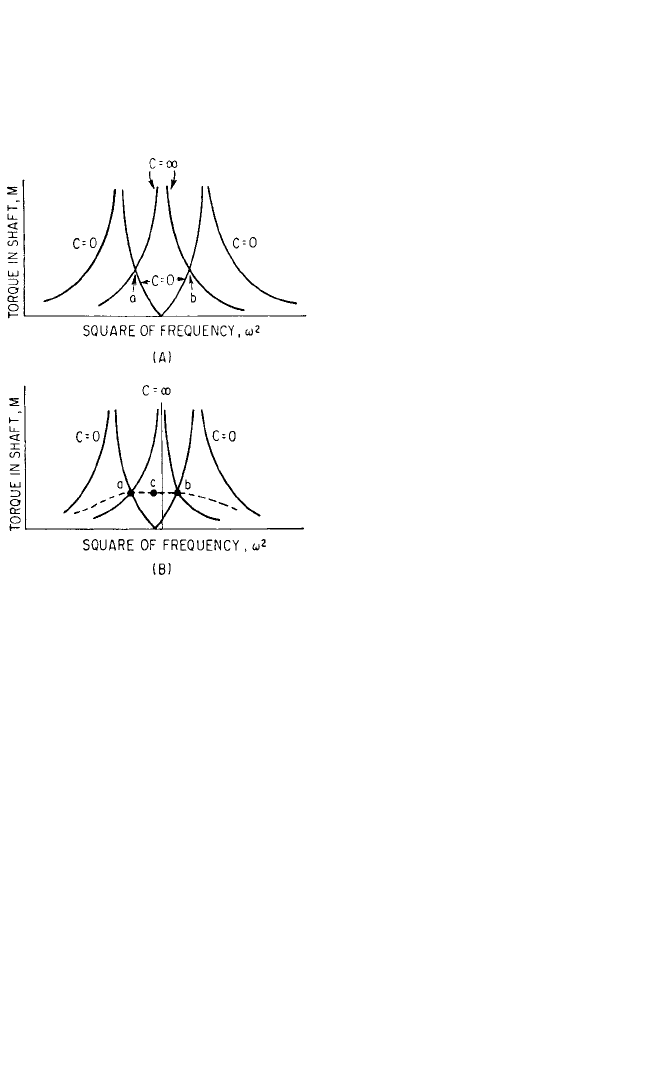
2. Plot the resonance curves of M for a particular section, first for the damper
locked, then with zero damping but the damper spring in place. All ordinates are
plotted positive. The curves have the general form of those shown in Fig. 38.20.They
intersect in two fixed points through
which all resonance curves pass, irre-
spective of the damping constant in the
damper. If the fixed point a is higher
than b, assume a lower constant for the
damper spring and recalculate the M
curve. If a is lower than b, do the reverse.
Thus adjust the damper spring constant
until a and b are of equal height. If this
amplitude M is higher than desired, it is
necessary to repeat the calculation with
a larger damper.
With the spring and damper mass
adjusted, a direct calculation (similar to
that for the untuned damper) can be
made to determine the damping con-
stant c
r
which will give the resonance
curve the same ordinate at an intermedi-
ate frequency indicated by point c as at a
and b. Figure 38.20B shows the reso-
nance curve of an ideally adjusted
damper.
3. For a range of frequencies, using
the inertia, spring, and damping con-
stants as determined above, compute the
amplitude of the damper mass relative
to its hub by a forced-vibration calcula-
tion. In this calculation the damper
spring constant becomes the complex number (k + jcω). The load for which the
damper springs must be designed is k times the relative amplitude of the damper
mass to its hub. The torque on the damper is approximately M
e
Σβ. For a discussion
on an untuned viscous damper, see Ref. 6.
Pendulum Dampers. The principle of a pendulum damper is shown in Fig.
38.21A. (Also see Chap. 6.) The hole-pin construction usually used, which is equiva-
lent to that of Fig. 38.21A, is shown in Fig. 38.21B. It is undesirable to have any fric-
tion in the damper. The damper produces an effect equivalent to a fixed flywheel,
and the inertia of this flywheel is different for each order of vibration.
The design formulas for the pendulum damper are as follows:
1
If the length L is
made equal to
L = (38.32)
the damper is said to be tuned to order q
0
. For excitation of q
0
cycles per revolution,
it will act as an infinite flywheel, keeping the shaft at its point of attachment to uni-
form rotation insofar as q
0
order vibrations are concerned. But other orders of vibra-
tion may exist in the shaft.
R
1 + q
0
2
TORSIONAL VIBRATION IN RECIPROCATING AND ROTATING MACHINES 38.31
FIGURE 38.20 Curves of torque vs. square of
frequency for auxiliary mass damper.
8434_Harris_38_b.qxd 09/20/2001 12:26 PM Page 38.31
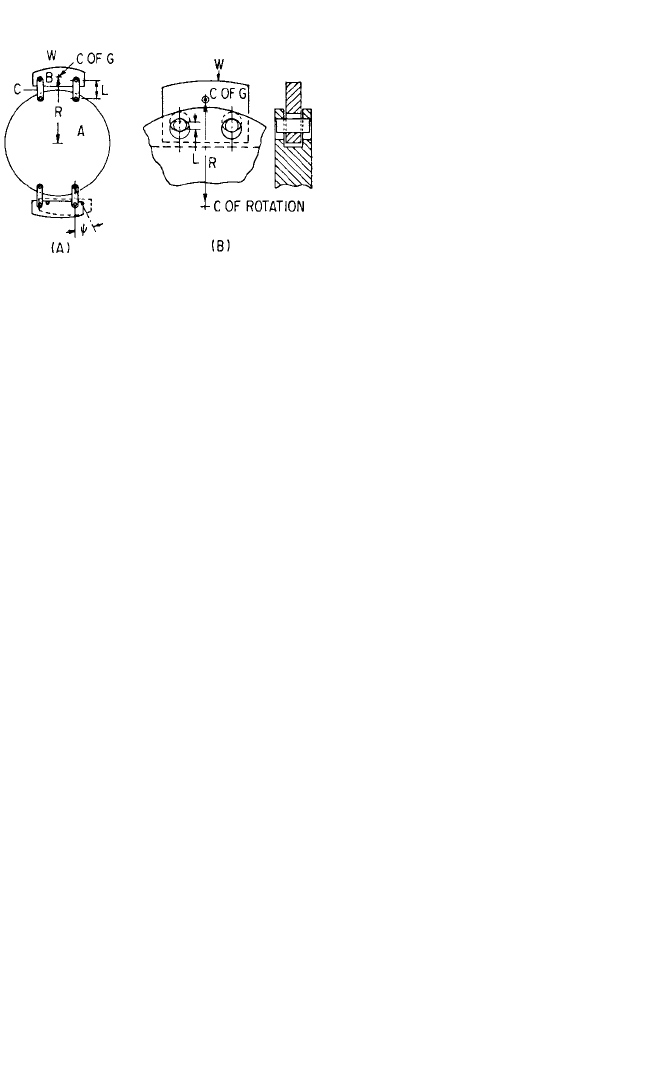
If the shaft at the point of attachment
of the damper is vibrating with order q
and amplitude θ, the maximum link
angle (see Fig. 38.21) is
= rad (38.33)
The torque exerted by a single ele-
ment of the damper is
M =
in.-lb
(38.34)
where W is the weight of an element and
J is the polar inertia of an element about its own center-of-gravity. The J term is
equivalent to an addition to the damper hub. Dropping this term, the damper is
equivalent to a flywheel of polar inertia
J
d
= in.
2
-lb (38.35)
For q < q
0
this is a positive flywheel, for q = q
0
an infinite flywheel, and for q > q
0
a
negative flywheel. Omitting the J term and eliminating θ between Eqs. (38.33) and
(38.34),
= rad (38.36)
In-Line Diesel Engine. As applied to a diesel engine, the above procedure is
much more difficult. The exciting torques in diesel engines are nearly independent
of speed. Hence from Eq. (38.36) it is evident that will be inversely proportional to
Ω
2
.Thus for a variable-speed engine the damper size is fixed by the low-speed end of
the range; if is kept in the 20 to 30° limit, the size may be excessive. This difficulty
usually can be overcome by tuning the damper as a negative flywheel, thus acting to
raise the undesired critical above the operating range while keeping to a reason-
able limit at low speed. The procedure is as follows:
Assuming a damper size and a q/q
0
ratio, a forced-vibration calculation is made
starting at the flywheel end, for the maximum speed of the engine. In this calculation
the damper is treated as a fixed flywheel of polar inertia n{[WR
e
(1 − q
2
/q
0
2
)
−1
] + J}
plus the inertia of the fixed carrier which supports the moving weights, where n is the
number of weights. This calculation will yield θ, the amplitude at the damper hub,
and the maximum torque in the engine shaft.Then is given by Eq. (38.33). If either
the shaft torque or the damper amplitude is too large, it is necessary to increase the
damper size and possibly adjust the q/q
0
ratio as well. A similar check for is made
at the low-speed end of the range with further adjustment of WR
e
and q/q
0
if neces-
sary.
With a pendulum damper fitted, the equivalent inertia is different for each order
of vibration so that each order has a different frequency. A damper tuned as a nega-
tive flywheel for one order becomes a positive flywheel for lower orders; thus, it
reduces the frequencies of those orders, with possibly unfortunate results.
M(1 + q
0
2
)g
q
0
2
WR
2
Ω
2
WR
2
1 − q
2
/q
0
2
q
2
Ω
2
θ
g
WR
2
1 − q
2
/q
0
2
+ J
θq
2
(1 + q
0
2
)
q
0
2
− q
2
38.32 CHAPTER THIRTY-EIGHT
FIGURE 38.21 Pendulum-type damper. The
arrangement is shown in principle at A, and the
Chilton construction is shown schematically at B.
8434_Harris_38_b.qxd 09/20/2001 12:26 PM Page 38.32

In in-line engines the application of a pendulum damper may be further compli-
cated by the necessity of suppressing several orders of vibration, thus requiring sev-
eral sets of damper weights. Alternatively, both a pendulum- and viscous-type
damper may be fitted to an engine.
In general, the pendulum-type dampers are more expensive than the viscous
types.Wear in the pins and their bushings changes the properties of the damper, thus
requiring replacement of these parts at intervals.
REFERENCES
1. Nestorides, E. J.: “A Handbook of Torsional Vibration,” Cambridge University Press, 1958.
2. Wilson, W. K.: “Practical Solutions of Torsional Vibration Problems,” John Wiley & Sons,
Inc., New York, 1942.
3. Porter, F.: Trans. ASME, 50:8 (1928).
4. Rao, S. S.: “Mechanical Vibration,” Addison-Wesley Publishing Co., Reading, Mass., 1990.
5. Lewis, F. M.: Trans. Soc. of Naval Arch. Marine Engrs., 33:109 (1925).
6. Thompson, W. T., and M. D. Dahleh: “Theory of Vibration with Applications,” 5th ed.,
Prentice-Hall, Inc., Upper Saddle River, N.J., 1998.
7. Eshleman, R. L.: “Torsional Response of Internal Combustion Engines,” Trans. ASME,
96(2):441 (1974).
8. Anwar, I.: “Computerized Time Transient Torsional Analysis of Power Trains,” ASME
Paper No. 79-DET-74, 1979.
9. Sohre, J. S.: “Transient Torsional Criticals of Synchronous Motor-Driven, High-Speed
Compressor Units,” ASME Paper No. 66-FE-22, June 1965.
10. U.S. Navy Department: “Military Standard Mechanical Vibrations of Mechanical Equip-
ment,” MIL-STD-167 (SHIPS).
11. American Petroleum Institute: “Centrifugal Compressors for General Refinery Service,”
API STD 617, Fifth ed. 1988, Washington, D.C.
12. Eshleman, R. L.: “Torsional Vibrations in Machine Systems,” Vibrations, 3(2):3 (1987).
13. Lewis, F. M.: Trans. ASME, 78:APM 377 (1955).
TORSIONAL VIBRATION IN RECIPROCATING AND ROTATING MACHINES 38.33
8434_Harris_38_b.qxd 09/20/2001 12:26 PM Page 38.33

CHAPTER 39, PART I
BALANCING OF
ROTATING MACHINERY
Douglas G. Stadelbauer
INTRODUCTION
The demanding requirements placed on modern rotating machines and equip-
ment—for example, electric motors and generators, turbines, compressors, and
blowers—have introduced a trend toward higher speeds and more stringent accept-
able vibration levels. At lower speeds, the design of most rotors presents few prob-
lems which cannot be solved by relatively simple means, even for installations in
vibration-sensitive environments. At higher speeds, which are sometimes in the
range of tens of thousands of revolutions per minute, the design of rotors can be an
engineering challenge which requires sophisticated solutions of interrelated prob-
lems in mechanical design, balancing procedures, bearing design, and the stability
of the complete assembly. This has made balancing a first-order engineering prob-
lem from conceptual design through the final assembly and operation of modern
machines.
This chapter describes some important aspects of balancing, such as the basic
principles of the process by which an optimum state of balance is achieved in a rotor,
balancing methods and machines, and definitions of balancing terms. The discussion
is limited to those principles, methods, and procedures with which an engineer
should be familiar in order to understand what is meant by “balancing.” Finally, a list
of definitions is presented at the end of it.
In addition to unbalance, there are many other possible sources of vibration in
rotating machinery; some of them are related to or aggravated by unbalance, and so,
under appropriate conditions, they may be of paramount importance. However, this
discussion is limited to the means by which the effect of once-per-revolution com-
ponents of vibration (i.e., the effects due to mass unbalance) can be minimized.
BASIC PRINCIPLES OF BALANCING
Descriptions of the behavior of rigid or flexible rotors are given as introductory
material in standard vibration texts, in the references listed at the end of Part I of this
chapter, and in the few books devoted to balancing. A similar description is included
here for the purpose of examining the principles which govern the behavior of rotors
as their speed of rotation is varied.
39.1
8434_Harris_39_b.qxd 09/20/2001 12:24 PM Page 39.1
